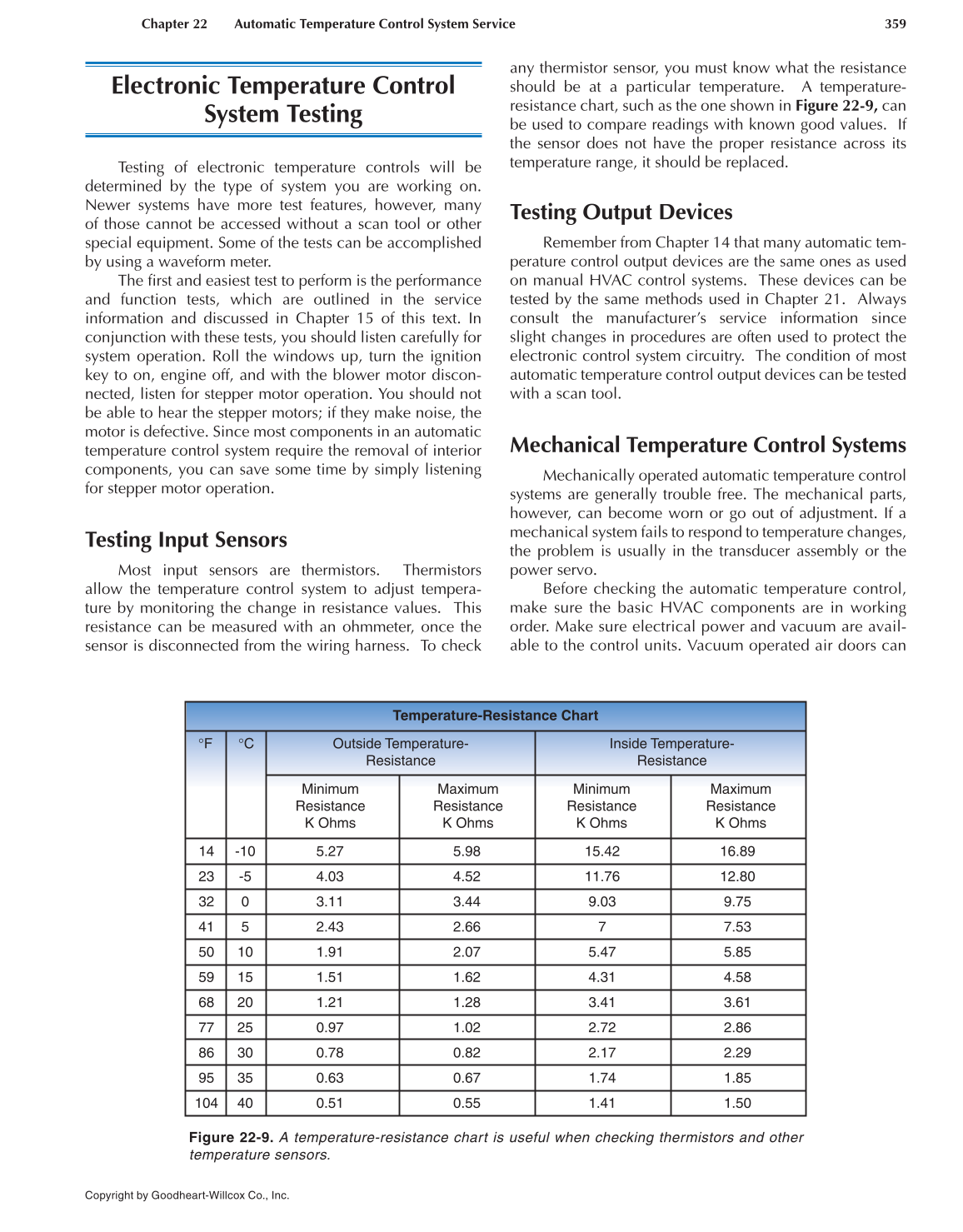Chapter 22 Automatic Temperature Control System Service 359
Copyright by Goodheart-Willcox Co., Inc.
Electronic Temperature Control
System Testing
Testing of electronic temperature controls will be
determined by the type of system you are working on.
Newer systems have more test features, however, many
of those cannot be accessed without a scan tool or other
special equipment. Some of the tests can be accomplished
by using a waveform meter.
The fi rst and easiest test to perform is the performance
and function tests, which are outlined in the service
information and discussed in Chapter 15 of this text. In
conjunction with these tests, you should listen carefully for
system operation. Roll the windows up, turn the ignition
key to on, engine off, and with the blower motor discon-
nected, listen for stepper motor operation. You should not
be able to hear the stepper motors; if they make noise, the
motor is defective. Since most components in an automatic
temperature control system require the removal of interior
components, you can save some time by simply listening
for stepper motor operation.
Testing Input Sensors
Most input sensors are thermistors. Thermistors
allow the temperature control system to adjust tempera-
ture by monitoring the change in resistance values. This
resis tance can be measured with an ohmmeter, once the
sensor is disconnected from the wiring harness. To check
any thermistor sensor, you must know what the resistance
should be at a particular temperature. A temperature-
resistance chart, such as the one shown in Figure 22-9, can
be used to compare readings with known good values. If
the sensor does not have the proper resistance across its
temperature range, it should be replaced.
Testing Output Devices
Remember from Chapter 14 that many automatic tem-
perature control output devices are the same ones as used
on manual HVAC control systems. These devices can be
tested by the same methods used in Chapter 21. Always
consult the manufacturer’s service information since
slight changes in procedures are often used to protect the
electronic control system circuitry. The condition of most
automatic temperature control output devices can be tested
with a scan tool.
Mechanical Temperature Control Systems
Mechanically operated automatic temperature control
systems are generally trouble free. The mechanical parts,
however, can become worn or go out of adjustment. If a
mechanical system fails to respond to temperature changes,
the problem is usually in the transducer assembly or the
power servo.
Before checking the automatic temperature control,
make sure the basic HVAC components are in working
order. Make sure electrical power and vacuum are avail-
able to the control units. Vacuum operated air doors can
Figure 22-9. A temperature-resistance chart is useful when checking thermistors and other
temperature sensors.
Temperature-Resistance Chart
°F °C Outside Temperature-
Resistance
Maximum
Resistance
K Ohms
Minimum
Resistance
K Ohms
Maximum
Resistance
K Ohms
Minimum
Resistance
K Ohms
Inside Temperature-
Resistance
-10
-5
0
5
10
15
20
25
30
35
40
14
23
32
41
50
59
68
77
86
95
104
5.27
4.03
3.11
2.43
1.91
1.51
1.21
0.97
0.78
0.63
0.51
5.98
4.52
3.44
2.66
2.07
1.62
1.28
1.02
0.82
0.67
0.55
15.42
11.76
9.03
7
5.47
4.31
3.41
2.72
2.17
1.74
1.41
16.89
12.80
9.75
7.53
5.85
4.58
3.61
2.86
2.29
1.85
1.50
